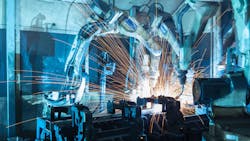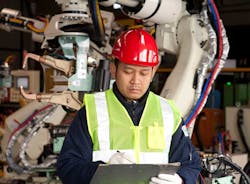Use of robots and cobots in manufacturing and other applications continues to grow. While not a new concept, they are still considered an emerging trend said Donna Ritson, President of DDR Communications, during her presentation at the National Fluid Power Association’s (NFPA) 2022 Industry & Economic Outlook Conference (IEOC).
This is due in part to the exponential growth seen in recent years for use of various types of robots as companies look to automate processes and overcome labor challenges. With this growth have come opportunities for component suppliers such as fluid power and motion control manufacturers as their products are often utilized within robots.
According to the results of a recent study conducted by DDR Communications on robots and cobots for PMMI—a global resource for the packaging and processing industry— and the NFPA, there are several opportunities for fluid power manufacturers in this sector, particularly for those who develop pneumatic components.
Pneumatics Offer Benefits and Challenges
For the PMMI study, Ritson’s company conducted 135 interviews and surveys with companies across the consumer packaged goods (CPG) industries which utilize a variety of production tools including robots. Discussions were had with companies large and small within the CPG industries, as well as with robot manufacturers, suppliers, and integrators to get their perspective on the state of the industry.
These discussions included learning more about the opportunities for pneumatics in the industry, of which there appear to be many. A key area robotics experts pointed to was the benefits of using pneumatics for end of arm tooling, said Ritson. “They are cost effective, easier to use, simpler to troubleshoot, lightweight, [and] powerful,” she said. “Pneumatics are a key component in robotic end effectors.”
Ritson added the use of pneumatics in robots can go beyond the typical applications of gripping, holding or moving something. They can also be used for driving, welding or boring tools at the end of a robot and other applications which are not “your typical lift, move, handle applications,” she said.
While there are benefits to utilizing pneumatics for robots, one of the challenges expressed by the robotics experts Ritson’s company spoke with is the limited access to compressed air. As robots begin to be used in more places around a manufacturing facility, they may be put in locations where there is no air supply which could be a hinderance to the use of pneumatics.
Another challenge is the lack of familiarity with pneumatics technology; many companies are used to systems run on electric which requires pneumatic suppliers to educate customers on the role their technology can play. Per a quote Ritson showed during her presentation which came from the study, “Electrical control technologies are just more well know than the intricacies and challenges that you have with pneumatics.”
Additional challenges pointed out by robotics experts include the need for a wider range of pneumatic solutions for cobots and robots as well as the limited safety features currently available to enable their use alongside humans. There is also a lack of qualified people capable of operating, troubleshooting and maintaining robots and cobots. Many facilities still have older equipment which their employees are used to, so it will be necessary to properly train people as newer technologies like robots are installed.
READ MORE: Pneumatics Help Automate Food Packaging
When to Use Pneumatics
To further understand how pneumatics can be used in robots and cobots, Ritson said her team asked the robotics experts how to go about choosing them over a servo-electric solution.
If a simple pick and place application, then pneumatics are the better choice. This is because of the benefits pneumatics offer regarding simplicity, sequential operation and safe operating modes. Pneumatics are also considered a workhorse which suits this type of repetitive work.
Servo-electric, on the other hand, is better suited for those applications where energy savings is desired or sophisticated motion paths will be utilized or there will be a need to teach or guide the robot where to go.
Determining the appropriate solution requires asking customers the following questions said Ritson:
- Is the task repetitive?
- Does the application require high accuracy and reliable repeatability?
- What type of an environment is it in?
- What operator skill level is needed?
- What other areas of operation is this going to impact in the future?
Because robots and cobots are becoming more ubiquitous to overcome the lack of skilled labor in manufacturing, the robots deployed need to be simple and easy to use which makes pneumatics the answer in many instances said Ritson.
She also noted an aspect which came up during discussions with robotics experts was the need to find labor on the design and engineering side for robots and the components within them. Along with this is the need to ensure end of arm tooling (EoAT) is designed correctly—which goes hand in hand with the need to know how to choose between pneumatics or servo-electronics. “That is a significant aspect that we continue to hear over and over,” she said regarding the need to design the EoAT in a manner to realistically assign it a task and then help that task come to light.
Areas showing the best promise for robots equipped with pneumatic components include processing as well as primary and secondary packaging applications which are all growing.
According to some of the robotics experts, pneumatic cobots are starting to enter the market which allow force and speed to be controlled through software configurations. This will bring about new possibilities and applications, said Ritson.
Robots Implementation and Design to Remain Areas of Growth
The lack of skilled labor in manufacturing will be the key driver for the continued growth and implementation of robots in the coming years. According to Ritson’s study, three out of five CPGs predict they will increase their use of robotics in the next 5 years.
Cobot usage is predicted to increase two-fold during that timeframe she said. “[CPGs are] looking for these to replace labor, be mobile and be flexible, achieve faster throughput and to have a pick, place, sort type of application.”
Labor challenges are driving the need for automation solutions like robots, but it is also important for CPGs and other manufacturers to justify the business case for implementing these technologies. As such, it is important for robotics manufacturers and component suppliers to ensure optimal design, programming, and services.
There are various ways manufacturers source their robots and EoAT designs. Per data shown by Ritson during the IEOC:
- 40% purchase the robot from a robot manufacturer but design the EoAT in-house,
- 28% custom design and integrate a total solution for the entire robot in-house, including the end effector,
- 14% do a combination of some design in-house and rely on the robot and EoAT supplier for some assistance,
- 9% design the robot in-house but outsource the design of the EoAT, and
- 9% outsource and buy existing robots from a certified integrator to assist with design all the way to the end effector.
She also shared that 18% of OEMs consistently outsource the EoAT design to a specialized supplier. All of these design cases provide potential opportunities for pneumatics suppliers whose components could be utilized in the robots.
Everyone Ritson and her team spoke to agreed that programming of robots is becoming easier. This is due in part to an increase in open, universal programs and easier to use software. As one SME said, software from different suppliers communicate well with one another but it would be helpful if there were a common language used to ensure proper communication between software programs.
As machine learning and artificial intelligence (AI) advance, the industry will move from programming to teaching a cobot or robot how to move. This will help make them easier to integrate into a facility and get up and running.
To enable the adoption of pneumatics in robots and cobots, Ritson said the robotics experts noted there were several functional improvements necessary including:
- More seamless integration of pneumatic control components; less programming, more teaching.
- Integration of pneumatic controls into the cobot – regulators, valves, feedback loops – to achieve plug-and-play compatibility.
- Ability to move heavier payloads - faster.
- Broader range of support for robotics.
READ MORE: Fluid Power Market to Continue in Positive Direction
What lies ahead?
Ritson said many of those surveyed agreed the adoption of AI will be key in the future for the continued implementation of robots. Both AI and self-learning will be important to managing various types of applications and making corrections on the fly.
Integration of vision systems, particularly 3D vision, will be beneficial as well. This will enable better visibility of the manufacturing facility and people and objects around the robot.
“They are going to be smarter. They are going to more configurable,” said Ritson in regard to robot designs in the future. In addition, “they are going to have adaptive intelligence, real-time reaction and tactical sensing.”
These advanced features and many others will be possible through the implementation of AI, machine learning and vision systems. And with these technologies the robots will be able to learn the maneuvers they need to make and adapt when necessary. “Vision systems are going to open up a lot of opportunities for robots overall,” said Ritson. And it is very likely end effectors will have some form of pneumatics on them in the future.
According to the Vice President of Engineering at a large OEM Ritson’s team spoke to who is the robotics expert at his company, pneumatics is the preferred power source for the end-effector tools because pneumatics is cost effective, lightweight, and powerful which makes it a natural match for robots offering EoAT variety.
In general, the growth for pneumatics in industrial manufacturing will be in cobots as they move into non-traditional areas, said Ritson, and pneumatics and compressed air technology is going to have to follow. Packaging, food and beverage, warehousing, autonomous vehicles, construction, and agricultural harvesting are just some of the markets in which this growth will take place.
For the first time in recent years, non-automotive applications comprise the greatest market share for robot installations. This is expected to continue in the coming years across the globe. Currently, China and Japan are the leaders followed by the U.S. But by 2024, the market is expected to reach 500,000 robot installations in a single year across various industries and North America is likely to account for the largest portion of this growth said Ritson.
As more companies install robots at their facilities, they will be looking to their suppliers for guidance on which types to utilize as well as best practices for implementation. These companies will also be looking for a partner who can help to provide integration, training, and service support, which could provide pneumatics suppliers an opportunity to differentiate themselves in this growing market.
About the Author
Sara Jensen
Executive Editor, Power & Motion
Sara Jensen is executive editor of Power & Motion, directing expanded coverage into the modern fluid power space, as well as mechatronic and smart technologies. She has over 15 years of publishing experience. Prior to Power & Motion she spent 11 years with a trade publication for engineers of heavy-duty equipment, the last 3 of which were as the editor and brand lead. Over the course of her time in the B2B industry, Sara has gained an extensive knowledge of various heavy-duty equipment industries — including construction, agriculture, mining and on-road trucks —along with the systems and market trends which impact them such as fluid power and electronic motion control technologies.
You can follow Sara and Power & Motion via the following social media handles:
X (formerly Twitter): @TechnlgyEditor and @PowerMotionTech
LinkedIn: @SaraJensen and @Power&Motion
Facebook: @PowerMotionTech

Leaders relevant to this article:




